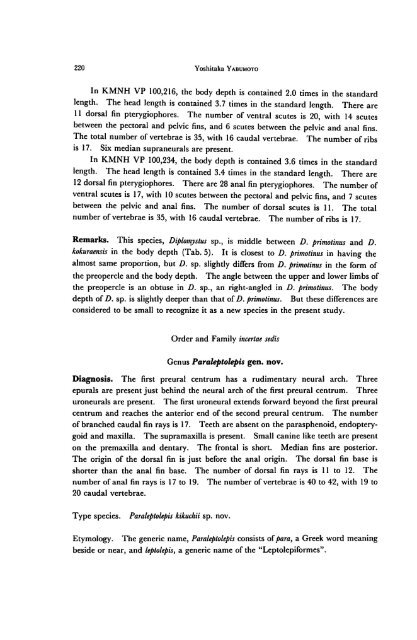Early Cretaceous Freshwater Fish Fauna in Kyushu, Japan
Early Cretaceous Freshwater Fish Fauna in Kyushu, Japan
Early Cretaceous Freshwater Fish Fauna in Kyushu, Japan
You also want an ePaper? Increase the reach of your titles
YUMPU automatically turns print PDFs into web optimized ePapers that Google loves.
220 Yoshitaka Yabumoto<br />
In KMNH VP 100,216, the body depth is conta<strong>in</strong>ed 2.0 times <strong>in</strong> the standard<br />
length. The head length is conta<strong>in</strong>ed 3.7 times <strong>in</strong> the standard length. There are<br />
11 dorsal f<strong>in</strong> pterygiophores. The number of ventral scutes is 20, with 14 scutes<br />
between the pectoral and pelvic f<strong>in</strong>s, and 6 scutes between the pelvic and anal f<strong>in</strong>s.<br />
The total number of vertebrae is 35, with 16 caudal vertebrae. The number of ribs<br />
is 17. Six median supraneurals are present.<br />
In KMNH VP 100,234, the body depth is conta<strong>in</strong>ed 3.6 times <strong>in</strong> the standard<br />
length. The head length is conta<strong>in</strong>ed 3.4 times <strong>in</strong> the standard length. There are<br />
12 dorsal f<strong>in</strong> pterygiophores. There are 28 anal f<strong>in</strong> pterygiophores. The number of<br />
ventral scutes is 17, with 10 scutes between the pectoral and pelvic f<strong>in</strong>s, and 7 scutes<br />
between the pelvic and anal f<strong>in</strong>s. The number of dorsal scutes is 11. The total<br />
number of vertebrae is 35, with 16 caudal vertebrae. The number of ribs is 17.<br />
Remarks. This species, Diplomyslus sp., is middle between D. primot<strong>in</strong>us and D.<br />
kokuraensis <strong>in</strong> the body depth (Tab. 5). It is closest to D. primot<strong>in</strong>us <strong>in</strong> hav<strong>in</strong>g the<br />
almost same proportion, but D. sp. slightly differs from D. primot<strong>in</strong>us <strong>in</strong> the form of<br />
the preopercle and the body depth. The angle between the upper and lower limbs of<br />
the preopercle is an obtuse <strong>in</strong> D. sp., an right-angled <strong>in</strong> D. primot<strong>in</strong>us. The body<br />
depth of D. sp. is slightly deeper than that of D. primot<strong>in</strong>us. But these differences are<br />
considered to be small to recognize it as a new species <strong>in</strong> the present study.<br />
Order and Family <strong>in</strong>certae sedis<br />
Genus Paraleptolepis gen. nov.<br />
Diagnosis. The first preural centrum has a rudimentary neural arch. Three<br />
epurals are present just beh<strong>in</strong>d the neural arch of the first preural centrum. Three<br />
uroneurals are present. The first uroneural extends forward beyond the first preural<br />
centrum and reaches the anterior end of the second preural centrum. The number<br />
of branched caudal f<strong>in</strong> rays is 17. Teeth are absent on the parasphenoid, endoptery<br />
goid and maxilla. The supramaxilla is present. Small can<strong>in</strong>e like teeth are present<br />
on the premaxilla and dentary. The frontal is short. Median f<strong>in</strong>s are posterior.<br />
The orig<strong>in</strong> of the dorsal f<strong>in</strong> is just before the anal orig<strong>in</strong>. The dorsal f<strong>in</strong> base is<br />
shorter than the anal f<strong>in</strong> base. The number of dorsal f<strong>in</strong> rays is 11 to 12. The<br />
number of anal f<strong>in</strong> rays is 17 to 19. The number of vertebrae is 40 to 42, with 19 to<br />
20 caudal vertebrae.<br />
Type species.<br />
Paraleptolepis kikuchii sp. nov.<br />
Etymology. The generic name, Paraleptolepis consists of para, a Greek word mean<strong>in</strong>g<br />
beside or near, and leptolepis, a generic name of the "Leptolepiformes".

















